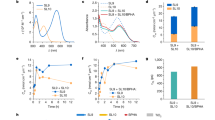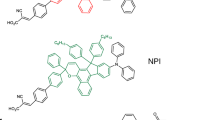Abstract
Conventional dye-sensitized solar cells have excellent charge collection efficiencies, high open-circuit voltages and good fill factors. However, dye-sensitized solar cells do not completely absorb all of the photons from the visible and near-infrared domain and consequently have lower short-circuit photocurrent densities than inorganic photovoltaic devices. Here, we present a new design where high-energy photons are absorbed by highly photoluminescent chromophores unattached to the titania and undergo Förster resonant energy transfer to the sensitizing dye. This novel architecture allows for broader spectral absorption, an increase in dye loading, and relaxes the design requirements for the sensitizing dye. We demonstrate a 26% increase in power conversion efficiency when using an energy relay dye (PTCDI) with an organic sensitizing dye (TT1). We estimate the average excitation transfer efficiency in this system to be at least 47%. This system offers a viable pathway to develop more efficient dye-sensitized solar cells.
This is a preview of subscription content, access via your institution
Access options
Subscribe to this journal
Receive 12 print issues and online access
$209.00 per year
only $17.42 per issue
Buy this article
- Purchase on Springer Link
- Instant access to full article PDF
Prices may be subject to local taxes which are calculated during checkout






Similar content being viewed by others
Change history
30 October 2009
The authors of the above article would like to add a citation to a highly relevant manuscript that was published in March 2009. The uncited manuscript is K. Shankar, X. Feng & C. A. Grimes ACS Nano 3, 788–794; 2009, and also uses a dye-molecule energy transfer approach to enhance solar cell efficiency. In addition, the authors wish to correct both the affiliation for Tomás Torres, and the acknowledgements section. These latter two corrections have been made in all versions of the article.
References
O'Regan, B. & Gratzel, M. A low-cost, high-efficiency solar cell based on dye-sensitized colloidal TiO2 films. Nature 353, 737–740 (1991).
Peter, L. M. Dye-sensitized nanocrystalline solar cells. Phys. Chem. Chem. Phys. 9, 2630–2642 (2007).
Snaith, H. J. & Schmidt-Mende, L. Advances in liquid-electrolyte and solid-state dye-sensitized solar cells. Adv. Mater. 19, 3187–3200 (2007).
Bisquert, J., Cahen, D., Hodes, G., Ruhle, S. & Zaban, A. Physical chemical principles of photovoltaic conversion with nanoparticulate, mesoporous dye-sensitized solar cells. J. Phys. Chem. B 108, 8106–8118 (2004).
Hagfeldt, A. & Gratzel, M. Molecular photovoltaics. Acc. Chem. Res. 33, 269–277 (2000).
Nazeeruddin, M. K. et al. Combined experimental and DFT-TDDFT computational study of photoelectrochemical cell ruthenium sensitizers. J. Am. Chem. Soc. 127, 16835–16847 (2005).
Hamann, T. W., Jensen, R. A., Martinson, A. B. F., Ryswyk, H. V. & Hupp, J. T. Advancing beyond current generation dye-sensitized solar cells. Energy Environ. Sci. 1, 66–78 (2008).
Gratzel, M. Conversion of sunlight to electric power by nanocrystalline dye-sensitized solar cells. J. Photochem. Photobiol. A 164, 3–14 (2004).
Wang, P. et al. A stable quasi-solid-state dye-sensitized solar cell with an amphiphilic ruthenium sensitizer and polymer gel electrolyte. Nature Mater. 2, 402–407 (2003).
Yum, J.-H. et al. Efficient far red sensitization of nanocrystalline TiO2 films by an unsymmetrical squaraine dye. J. Am. Chem. Soc. 129, 10320–10321 (2007).
Burke, A., Schmidt-Mende, L., Ito, S. & Gratzel, M. A novel blue dye for near-IR ‘dye-sensitized’ solar cell applications. Chem. Commun. 3, 234–236 (2006).
Campbell, W. M. et al. Highly efficient porphyrin sensitizers for dye-sensitized solar cells. J. Phys. Chem. C 111, 11760–11762 (2007).
He, J. et al. Modified phthalocyanines for efficient near-IR sensitization of nanostructured TiO2 electrode. J. Am. Chem. Soc. 124, 4922–4932 (2002).
Cid, J.-J. et al. Molecular cosensitization for efficient panchromatic dye-sensitized solar cells. Angew. Chem. 119, 8510–8514 (2007).
Tachibana, Y., Nazeeruddin, M. K., Grätzel, M., Klug, D. R. & Durrant, J. R. Electron injection kinetics for the nanocrystalline TiO2 films sensitised with the dye (Bu4N)2Ru(dcbpyH)2(NCS)2 . Chem. Phys. 285, 127–132 (2002).
Tachibana, Y., Moser, J. E., Gratzel, M., Klug, D. R. & Durrant, J. R. Subpicosecond interfacial charge separation in dye-sensitized nanocrystalline titanium dioxide films. J. Phys. Chem. 100, 20056–20062 (1996).
Haque, S. A. et al. Parameters influencing charge recombination kinetics in dye-sensitized nanocrystalline titanium dioxide films. J. Phys. Chem. B 104, 538–547 (2000).
Nazeeruddin, M. K. et al. Conversion of light to electricity by cis-X2bis(2,2′-bipyridyl-4,4′-dicarboxylate)ruthenium(II) charge-transfer sensitizers (X = Cl−, Br−, I−, CN− and SCN−) on nanocrystalline titanium dioxide electrodes. J. Am. Chem. Soc. 115, 6382–6390 (1993).
Haque, S. A., Tachibana, Y., Klug, D. R. & Durrant, J. R. Charge recombination kinetics in dye-sensitized nanocrystalline titanium dioxide films under externally applied bias. J. Phys. Chem. B 1998, 1745–1749 (1998).
O'Regan, B. C. et al. Catalysis of recombination and its limitation on open circuit voltage for dye sensitized photovoltaic cells using phthalocyanine dyes. J. Am. Chem. Soc. 130, 2906–2907 (2008).
O'Regan, B. C. et al. Structure/function relationships in dyes for solar energy conversion: a two-atom change in dye structure and the mechanism for its effect on cell voltage. J. Am. Chem. Soc. 131, 3541–3548 (2009).
Clifford, J. N., Palomares, E., Nazeeruddin, M. K., Gratzel, M. & Durrant, J. R. Dye dependent regeneration dynamics in dye sensitized nanocrystalline solar cells: Evidence for the formation of a ruthenium bipyridyl cation/iodide intermediate. J. Phys. Chem. C 111, 6561–6567 (2007).
Siegers, C. et al. A dyadic sensitizer for dye solar cells with high energy-transfer efficiency in the device. Chem. Phys. Chem. 8, 1548–1556 (2007).
Hu, X. & Schulten, K. How nature harvests sunlight. Phys. Today 50, 28–34 (1997).
Hu, X., Damjanovic, A., Ritz, T. & Schulten, K. Architecture and mechanism of the light-harvesting apparatus of purple bacteria. Proc. Natl Acad. Sci. USA 95, 5935–5941 (1998).
Pullerits, T. & Sundstrom, V. Photosynthetic light-harvesting pigment–protein complexes: Toward understanding how and why. Acc. Chem. Res. 29, 381–389 (1996).
Hardin, B. E. in et al. Materials Research Society Fall Meeting (Boston, MA, 2008).
Siegers, C. et al. Overcoming kinetic limitations of electron injection in the dye solar cell via coadsorption and FRET. Chem. Phys. Chem. 9, 793–798 (2008).
Bach, U. et al. Solid-state dye-sensitized mesoporous TiO2 solar cells with high photon-to-electron conversion efficiencies. Nature 395, 583–585 (1998).
Snaith, H. J. et al. Efficiency enhancements in solid-state hybrid solar cells via reduced charge recombination and increased light capture. Nano Lett. 7, 3372–3376 (2007).
Mor, G. K., Shankar, K., Paulose, M., Varghese, O. K. & Grimes, C. A. Use of highly-ordered TiO2 nanotube arrays in dye-sensitized solar cells. Nano Lett. 6, 215–218 (2006).
Law, M., Greene, L. E., Johnson, J. C., Saykally, R. & Yang, P. Nanowire dye-sensitized solar cells. Nature Mater. 4, 455–459 (2005).
Forster, T. Transfer mechanisms of electronic excitation. Discuss. Faraday Soc. 27, 7 (1959).
Scully, S. R., Armstrong, P. B., Edder, C., Frechet, J. M. J. & McGehee, M. D. Long-range resonant energy transfer for enhanced exciton harvesting for organic solar cells. Adv. Mater. 19, 2961–2966 (2007).
Liu, Y. X., Summers, M. A., Edder, C., Fréchet, J. M. J. & McGehee, M. D. Using resonance energy transfer to improve exciton harvesting in organic–inorganic hybrid photovoltaic cells. Adv. Mater. 17, 2960–2964 (2005).
Hill, Z. B., Rodovsky, D. B., Leger, J. M. & Bartholomew, G. P. Synthesis and utilization of perylene-based n-type small molecules in light-emitting electrochemical cells. Chem. Commun. 6594–6596 (2008).
Wurthner, F. Perylene bisimide dyes as versatile building blocks for functional supramolecular architectures. Chem. Commun. 1564–1579 (2004).
Lakowicz, J. R. Principles of Fluorescence Spectroscopy (Plenum, 1999).
Stern, V. O. & Volmer, M. Uber die abklingungszeit der fluoreszenz. Zeitschrift für Physik 20, 183–189 (1919).
Mac, M., Wach, A. & Najbar, J. Solvents effects on the fluorescence quenching of anthracene by iodide ions. Chem. Phys. Lett. 176, 167–172 (1991).
Sommeling, P. M. et al. Influence of a TiCl4 post-treatment on nanocrystalline TiO2 films in dye-sensitized solar cells. J. Phys. Chem. B 110, 19191–19197 (2006).
Yum, J.-H. et al. Effect of coadsorbent on the photovoltaic performance of zinc pthalocyanine-sensitized solar cells. Langmuir 24, 5636–5640 (2008).
Haque, S. A. et al. Charge separation versus recombination in dye-sensitized nanocrystalline solar cells: the minimization of kinetic redundancy. J. Am. Chem. Soc. 127, 3456–3462 (2005).
Huang, S., Schlichthorl, G., Nozik, A., Gratzel, M. & Frank, A. Charge recombination in dye-sensitized nanocrystalline TiO2 solar cells. J. Phys. Chem. B 101, 2576–2582 (1997).
Kebede, Z. & Lindquist, S.-E. Donor–acceptor interaction between non-aqueous solvents and I2 to generate I3−, and its implication in dye sensitized solar cells. Solar Energy Mater. Solar Cells 57, 259–275 (1999).
Fabregat-Santiago, F., Bisquert, J., Garcia-Belmonte, G., Boschloo, G. & Hagfeldt, A. Influence of electrolyte in transport and recombination in dye-sensitized solar cells studied by impedance spectroscopy. Solar Energy Mater. Solar Cells 87, 117–131 (2005).
Haque, S. A. et al. Charge separation versus recombination in dye-sensitized nanocrystalline solar cells: The minimization of kinetic redundancy. J. Am. Chem. Soc. 127, 3456–3462 (2005).
Ito, S. et al. Fabrication of thin film dye sensitized solar cells with solar to electric power conversion efficiency over 10%. Thin Solid Films 516, 4613–4619 (2008).
Klok, H. A., Hernández, J. R., Becker., S. & Müllen, K. Star-shaped fluorescent polypeptides. J. Polym. Sci. Part A: Polym. Chem. 39, 1572–1583 (2001).
Ito, S. et al. Calibration of solar simulator for evaluation of dye-sensitized solar cells. Solar Energy Mater. Solar Cells 82, 421–429 (2004).
Acknowledgements
The authors thank Y.C. Jun and M.L. Brongersma for access to time–resolved PL measurement equipment and assistance with measurements. B.E.H. would like to thank P. Péchy for his assistance in making the electrolyte. This work was supported by the King Abdullah University of Science and Technology Center for Advanced Molecular Photovoltaics and by the Office of Naval Research contract no. N00014-08-1-1163. B.E.H. received financial support from the National Department of Defense Science and Engineering Graduate Fellowship (NDSEG). E.T.H. is supported by the National Science Foundation GRFP and the Fannie and John Hertz Foundation. J.M.F. is supported by DOEBES contract DE-AC02-05CH11231. Financial support from ESF (SOHYDs), EU (ROBUST DSC, FP7-Energy-2007-1-RTD, 212792), MCyT (CTQ2008-00418/BQU, Consolider-Ingenio 2010 CSD2007-00010), MICINN (FOTOMOL, PSE-120000-2008-3) and CAM (MADRISOLAR, S-0505/PPQ/0225) are also gratefully acknowledged.
Author information
Authors and Affiliations
Contributions
B.E.H. assembled the DSCs and performed measurements for Figs 3, 5 and 6. E.T.H. modelled the excitation transfer efficiency for the spherical and cylindrical geometries shown in Fig. 4. P.B.A. synthesized the ERD (PTCDI) and T.T. synthesized the sensitizing dye (TT1). P.C. fabricated the TiO2 electrodes and provided BET data to determine pore size. J.Y.H. and M.K.N. measured dye absorption and dye adsorption on TiO2 and provided guidance in electrolyte design. J.M.J., M.G. and M.D.M. provided technical advice on dye design and DSC device physics.
Corresponding author
Supplementary information
Rights and permissions
About this article
Cite this article
Hardin, B., Hoke, E., Armstrong, P. et al. Increased light harvesting in dye-sensitized solar cells with energy relay dyes. Nature Photon 3, 406–411 (2009). https://doi.org/10.1038/nphoton.2009.96
Received:
Accepted:
Published:
Issue Date:
DOI: https://doi.org/10.1038/nphoton.2009.96
This article is cited by
-
Experimental evidence of Förster energy transfer enhancement in the near field through engineered metamaterial surface waves
Communications Physics (2023)
-
Stability and efficiency improvement of TiO2-based dye-sensitized solar cells by surface modification of MgO
Journal of Solid State Electrochemistry (2023)
-
Employing Novel Si-Over-Si Technology to Optimize PV Effect in Solar Array
Silicon (2022)
-
Photoelectrochemical energy conversion using hybrid photoelectrodes
Materials for Renewable and Sustainable Energy (2022)
-
Effects of annealing temperature on TiO2 photoelectrodes of dye-sensitized solar cells using Ixora coccenia dye extract
Journal of Nanoparticle Research (2021)



